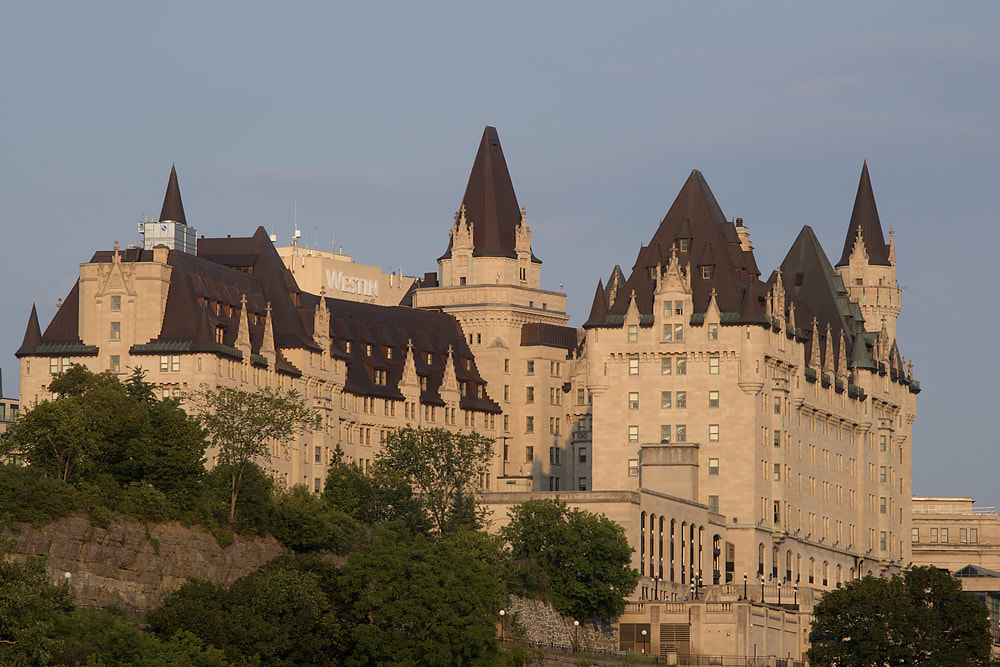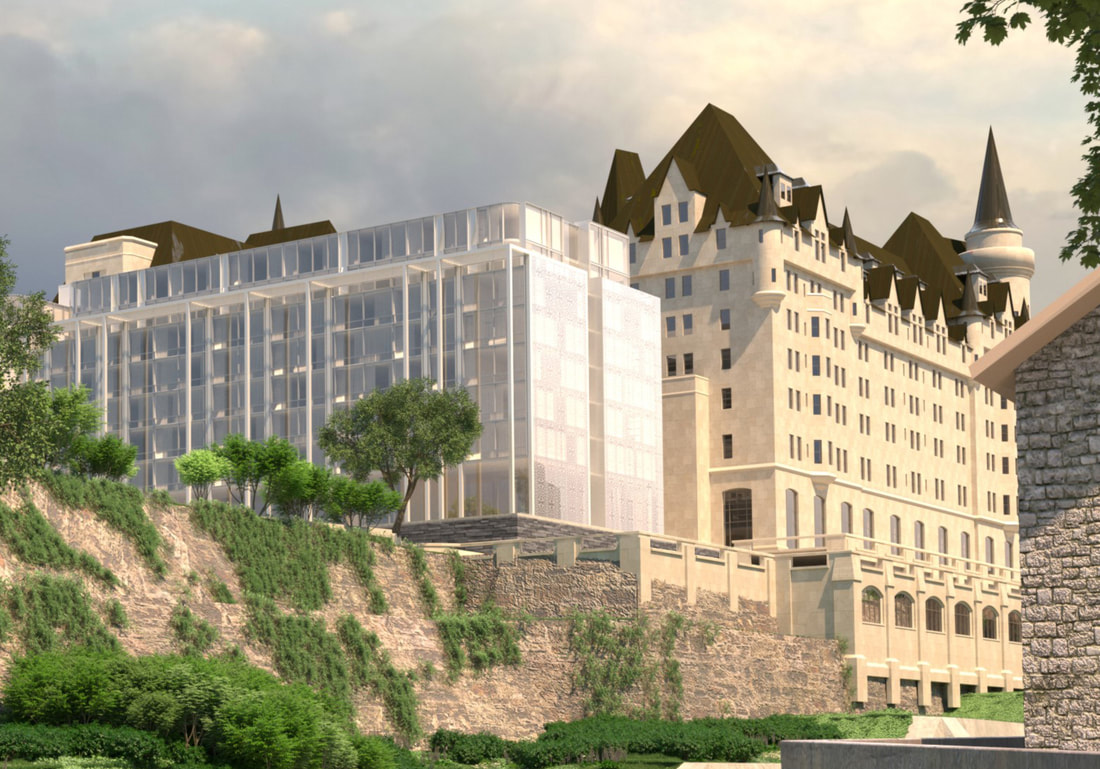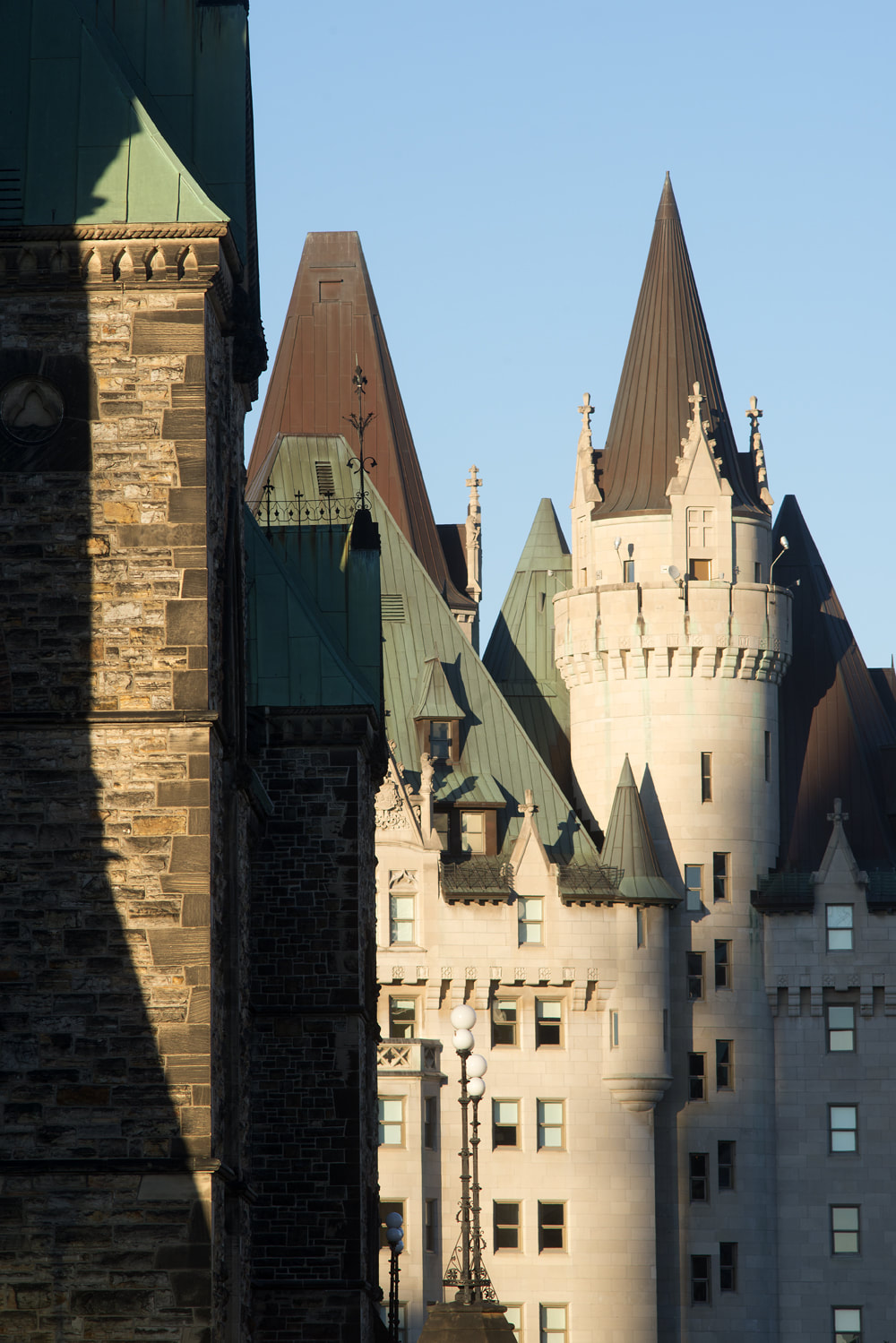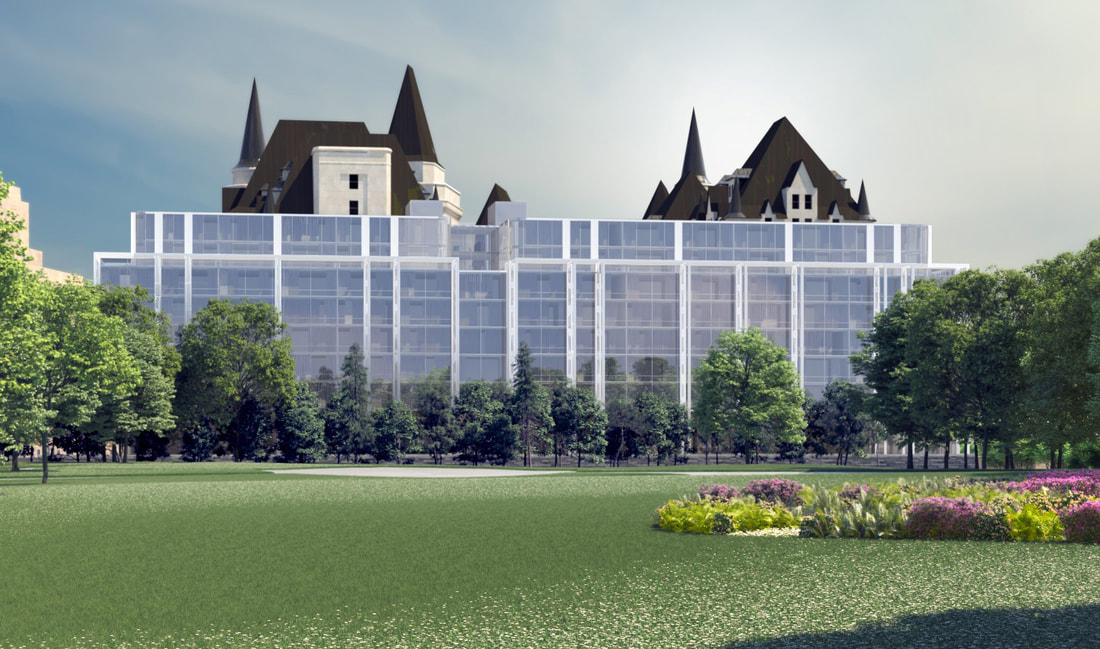|
One of the more surreal moments during last month’s open house on the proposed Château Laurier expansion was hearing Michael McClelland mansplain that Sophisticated Europeans love this kind of design, and Ottawans really need to get with it.
I actually know a few Sophisticated Europeans, and in fact one of them was in Ottawa recently to give a couple of lectures at Carleton University. Dr. John Goodall is an architectural historian and has been the Architectural Editor of Country Life magazine since 2007; previous to that he was a Senior Properties Historian at English Heritage. He is the author of many articles and books – including the magnificent 480-page tome The English Castle, published by Yale University Press. So he knows a thing or two about architecture, especially about castles. While here, he took several walks around downtown Ottawa, guided by Andrew Waldron’s book Exploring the Capital. He expressed great enthusiasm for the area around Parliament Hill, so I showed him the renderings of the proposed extension of the Château Laurier. Here is his reaction: The view of the Canadian Parliament across the Ottawa River is emblematic not only of the capital, but of Canada itself. Chateau Laurier forms an important element of this spectacular prospect, its dramatic Gothic outline and detailing acting as a visual foil to Parliament. That this national view should be sacrificed to a clumsily designed hotel extension—literally a massive glass box—ought to provoke a national outcry. I know a few other Sophisticated Europeans, so I may try to get in touch with them, too. In the meantime, let’s start work on that national outcry. Peter Coffman Peter.coffman@carleton.ca Note: Due to a labour dispute between CUPE 2424 and Carleton University, my HTA blog will be located here for the time being. Normal service will resume once the dispute is resolved. If you don't want to see this... ...replaced with this: Then let City Hall know what you think before it's too late.
The deadline for public feedback is today, Friday March 9. Go to https://s-ca.chkmkt.com/?e=109220&h=EEDC2E57D5C3D5F&l=en Peter Coffman peter.coffman@carleton.ca Wouldn't this be the perfect place for your honeymoon: And wouldn't this be just about adequate for your AGM: Now, if you think there's a difference between a honeymoon and an AGM, you have just a few hours to put your views on record with the people at City Hall who will decide whether this abomination proceeds.
Go to this link to add your voice before it's too late. Peter Coffman peter.coffman@carleton.ca If heritage preservation in Ottawa had a doomsday clock, its hands would be spinning wildly toward midnight right now. Why? Because we are fast running out of time to prevent what would be remembered as the most outrageous act of heritage vandalism of our generation.
March 9 – this Friday – is the deadline for submitting feedback to the City on the proposed addition to the Château Laurier. It’s time for everyone who has been tweeting, retweeting, liking and commenting to make their voices heard in the one forum that City Hall won’t be allowed to ignore. Here’s the place to do it: https://s-ca.chkmkt.com/?e=109220&h=EEDC2E57D5C3D5F&l=en I can’t stress enough how important this is. If we go quiet, the addition goes ahead. Heritage is our birthright, not the property of developers to dole out as they see fit. This is a watershed moment for heritage preservation in this city – if we can’t save the Château Laurier from disfigurement, we can’t save anything. Ottawa, we mustn’t blow this. Peter Coffman peter.coffman@carleton.ca Note: Due to a labour dispute between CUPE 2424 and Carleton University, my HTA blog will be located here for the time being. Normal service will resume once the dispute is resolved. Note: Due to a labour dispute between CUPE 2424 and Carleton University, my HTA blog will be located here for the time being. Normal service will resume once the dispute is resolved.
In my last blog, I talked about the process at City Hall’s recent Château Laurier Open House. Today, I want to discuss the content. First observation: after hearing Peter Clewes and Michael McClelland pontificating on the Gothic Revival and the Picturesque, and chiding the audience for not showing sufficiently European sophistication, I have never understood the term ‘mansplaining’ so well as I did that night. Architect Peter Clewes spent a remarkable amount of time focusing on the virtues of the enclosed courtyard that will result from the addition of a fourth wing to the currently U-shaped building. I say ‘remarkable’ because this was a public audience of Ottawa residents, and that admirable courtyard will only benefit guests of the hotel. Even more importantly, having a beautiful courtyard is in no way dependent on having a bad addition. The other theme that Clewes stressed repeatedly was that the addition was ‘deferential’ to the original building. One of the key points in defence of this was the lowering of the roof of the addition to the bottom of the roofline of the Château, allegedly leaving the distinctive silhouette of the Château intact. The problem is, this really only works in the elevation drawing – as soon as you’re in the real world and at ground level, the angle of view changes and the old roof starts to disappear from view. As you walk toward the Château through Major’s Hill Park, the gables and turrets sink lower and lower, like the flailing hands of a drowning man before he finally sinks below the surface for the last time. The other argument for ‘deferential’ appeared to hinge on a touching, child-like faith that if the surface is clad in glass, the addition will essentially be transparent. Now, this may be true if the interior walls and floors are also glass, all the furniture and structural steel are removed, and everyone inside wears Harry Potter-like invisibility cloaks. Barring that, it’s just a new twist on the belief that ‘if I close my eyes you can’t see me’. Let’s be clear. All this talk about being ‘deferential’ is nothing more than the architect’s search for a rationale, however feeble, for designing the kind of thing he always designs and sticking it onto the back of the Château Laurier. It’s the architectural equivalent of plausible deniability. Michael McClelland, introduced as the heritage architect for the project, invoked the picturesque in support of the design. This surprised me, because a clear-headed understanding of the picturesque actually puts much of what is wrong with the design into sharp focus. What McClelland seemed to be arguing was that the picturesque valued variety, therefore a modern addition to a châteauesque building actually fits with the Château’s picturesque quality rather than violating it. Wow! I used to think that design – especially picturesque design, which is famously complex and subtle – was hard! That it required skill, judgement, effort and care! Turns out that making something picturesque is just a matter of assembling a ragbag of forms that have nothing to do with each other: round + square + jagged + pointy = picturesque = beautiful. What suckers architects like John Nash and John Soane were, with their painstakingly crafted vistas and minutely balanced compositions. Sarcasm aside, if you want to see stylistic variety that works, you don’t have to go far from home. Just glance across the canal, and see how the 20th-century, Beaux-Arts influenced Gothic Centre Block harmonizes with the Victorian Gothic East and West Blocks. Or walk along Wellington to the Bank of Canada, and see how 1970s Modernism can embrace and complement 1930s Classicism. Or go around the corner to the 2004 addition to the Lord Elgin Hotel, and see what ‘deferential’ really looks like. Then have another look at the proposed addition to the Château Laurier, and tell me if you think you’re seeing anything like same degree of care, thought and respect. One stunningly tone-deaf moment summed up the whole Open House. ‘It’s alright’, declared Michael McClelland, ‘to be modern!’ Yes, obviously it’s alright to be modern – Ottawa has several brilliant modern buildings. What’s not alright is to stick a grotesquely incongruous and intrusive addition onto an iconic heritage building at the heart of the national capital. Can they really not see the difference? Peter Coffman peter.coffman@carleton.ca |
AuthorThis is the temporary home of Peter's Carleton University History and Theory of Architecture (HTA) blog. ArchivesCategories |





 RSS Feed
RSS Feed